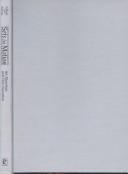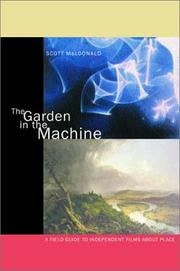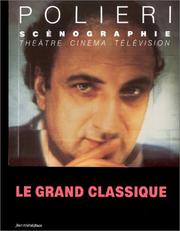| Listing 1 - 10 of 11 | << page >> |
Sort by
|
Book
ISBN: 0810139235 0810139219 Year: 2019 Publisher: Evanston, Illinois : Northwestern University Press,
Abstract | Keywords | Export | Availability | Bookmark
 Loading...
Loading...Choose an application
- Reference Manager
- EndNote
- RefWorks (Direct export to RefWorks)
"In this book, Thomas J. Connelly draws on a number of key psychoanalytic concepts from the works of Jacques Lacan, Slavoj Žižek, Joan Copjec, Michel Chion, and Todd McGowan to identify and describe a genre of cinema characterized by spatial confinement. Examining classic films such as Alfred Hitchcock's Rope and Stanley Kubrick's The Shining, as well as current films such as Room, Green Room, and 10 Cloverfield Lane, Connelly shows that the source of enjoyment of confined spaces lies in the viewer's relationship to excess. Cinema of Confinement offers rich insights into the appeal of constricted filmic spaces at a time when one can easily traverse spatial boundaries within the virtual reality of cyberspace."
Excess (Philosophy) --- Motion pictures --- Setting and scenery. --- Scenery (Motion pictures) --- Setting (Motion pictures) --- Philosophy --- Art direction
Book
ISBN: 3035614318 3035614342 9783035614312 9783035614374 Year: 2017 Publisher: Berlin Boston
Abstract | Keywords | Export | Availability | Bookmark
 Loading...
Loading...Choose an application
- Reference Manager
- EndNote
- RefWorks (Direct export to RefWorks)
"Ich bin das Kino-Auge. Ich bin ein Baumeister", schrieb der Filmregisseur Dziga Vertov. Wo gefilmt wird, fängt die Kamera unweigerlich jene Räume ein, die sich vor ihrer Linse befinden. Doch begnügt sich das Kino nicht damit, existierende Bauwerke abzubilden; mit seinen Methoden der Bewegung, der Kadrage und der Montage durchkreuzt, manipuliert und konstruiert es Architekturen. Architektur ist somit für den Film nicht bloß Sujet, der Film ist vielmehr, wie Eric Rohmer schreibt, selbst schon "eine Kunst der Raumorganisation". So spiegelt der Film einerseits die Tätigkeit von Architekturschaffenden und macht andererseits das Kino zu deren Lern- und Experimentierfeld. 13 Originalbeiträge entfalten Aspekte der so inspirierenden wie komplexen Beziehung zwischen Architektur und Film.
Motion pictures --- Motion pictures and architecture. --- Architecture and motion pictures --- Architecture --- Scenery (Motion pictures) --- Setting (Motion pictures) --- Setting and scenery. --- Art direction

ISBN: 0813521602 9780813521602 0813521610 9780813521619 Year: 1995 Publisher: New Brunswick, N.J. Rutgers University Press
Abstract | Keywords | Export | Availability | Bookmark
 Loading...
Loading...Choose an application
- Reference Manager
- EndNote
- RefWorks (Direct export to RefWorks)
Motion pictures --- 791.42 --- CDL --- Scenery (Motion pictures) --- Setting (Motion pictures) --- Art direction --- Art direction. --- Setting and scenery. --- Production and direction --- Setting and scenery
Book
ISBN: 9780813564098 9780813564081 9780813564104 9780813575490 0813564107 0813564093 0813564085 0813575494 Year: 2016 Publisher: New Brunswick, N.J. Rutgers University Press
Abstract | Keywords | Export | Availability | Bookmark
 Loading...
Loading...Choose an application
- Reference Manager
- EndNote
- RefWorks (Direct export to RefWorks)
In the early days of filmmaking, before many of Hollywood's elaborate sets and soundstages had been built, it was common for movies to be shot on location. Decades later, Hollywood filmmakers rediscovered the practice of using real locations and documentary footage in their narrative features. Why did this happen? What caused this sudden change? Renowned film scholar R. Barton Palmer answers this question in Shot on Location by exploring the historical, ideological, economic, and technological developments that led Hollywood to head back outside in order to capture footage of real places. His groundbreaking research reveals that wartime newsreels had a massive influence on postwar Hollywood film, although there are key distinctions to be made between these movies and their closest contemporaries, Italian neorealist films. Considering how these practices were used in everything from war movies like Twelve O'Clock High to westerns like The Searchers, Palmer explores how the blurring of the formal boundaries between cinematic journalism and fiction lent a "reality effect" to otherwise implausible stories. Shot on Location describes how the period's greatest directors, from Alfred Hitchcock to Billy Wilder, increasingly moved beyond the confines of the studio. At the same time, the book acknowledges the collaborative nature of moviemaking, identifying key roles that screenwriters, art designers, location scouts, and editors played in incorporating actual geographical locales and social milieus within a fictional framework. Palmer thus offers a fascinating behind-the-scenes look at how Hollywood transformed the way we view real spaces.
Film --- Los Angeles [California] --- Motion pictures --- Cinema --- Feature films --- Films --- Movies --- Moving-pictures --- Audio-visual materials --- Mass media --- Performing arts --- Scenery (Motion pictures) --- Setting (Motion pictures) --- Setting and scenery. --- Production and direction --- History --- History and criticism --- Art direction
Periodical
Abstract | Keywords | Export | Availability | Bookmark
 Loading...
Loading...Choose an application
- Reference Manager
- EndNote
- RefWorks (Direct export to RefWorks)
Theater --- Motion pictures --- Theater. --- Uitvoerende kunsten. --- Setting and scenery --- Setting and scenery. --- Dramatics --- Histrionics --- Professional theater --- Stage --- Theatre --- Scenery (Motion pictures) --- Setting (Motion pictures) --- Cinema --- Feature films --- Films --- Movies --- Moving-pictures --- History and criticism --- Performing arts --- Acting --- Actors --- Audio-visual materials --- Mass media --- Art direction
Periodical
Abstract | Keywords | Export | Availability | Bookmark
 Loading...
Loading...Choose an application
- Reference Manager
- EndNote
- RefWorks (Direct export to RefWorks)
Theater --- Motion pictures --- Performing arts --- Théâtre --- Cinéma --- Arts du spectacle --- Performing arts. --- Theater. --- Uitvoerende kunsten. --- Setting and scenery --- Décors --- Setting and scenery. --- Dramatics --- Histrionics --- Professional theater --- Stage --- Theatre --- Show business --- Scenery (Motion pictures) --- Setting (Motion pictures) --- Cinema --- Feature films --- Films --- Movies --- Moving-pictures --- History and criticism --- Acting --- Actors --- Arts --- Performance art --- Audio-visual materials --- Mass media --- Art direction
Book
ISBN: 3110531283 3110531739 311053049X Year: 2017 Publisher: De Gruyter
Abstract | Keywords | Export | Availability | Bookmark
 Loading...
Loading...Choose an application
- Reference Manager
- EndNote
- RefWorks (Direct export to RefWorks)
Wie werden komplexe Sinn-, Identitäts- und Wertekonstruktionen in den zeitlichen und dynamischen Mustern medialer Formen und Praktiken hergestellt? Wie generieren und transformieren filmische Bilder die affektiv grundierten Strukturen, in denen der Wertehorizont eines Gemeinwesens vermessen, bestätigt oder revidiert wird? In dieser Arbeit wird die These vertreten, dass die konkreten zeitlichen und dynamischen Strukturen der Filme je kulturell und historisch spezifisch zu verortende Muster der Welterfahrung hervorbringen. Anhand des (kollektiven) Schuldgefühls, dem Affekt der Irreversibilität, zeigt diese Arbeit, wie eine ästhetische Modulation moralischer Gefühle als das Kalkül audiovisueller Inszenierungsmuster beschrieben werden kann. Dieses Kalkül wird anhand von drei exemplarischen Gegenständen - das deutsche Nachkriegskino, der Hollywood-Western und Vietnamkriegsfilm sowie Filme zum Klimawandel - beschrieben und filmanalytisch greifbar gemacht. Audiovisuelle Inszenierungsmodi und ihre Modellierungen des Fühlens sollen so als eine kulturelle Praxis verdeutlicht werden, die an den Möglichkeitsbedingungen politischer Gemeinwesen und ihrer Geschichtlichkeit arbeitet.
Guilt. --- Motion pictures --- Affektpoetik. --- Audiovisuelle Rhetorik. --- Feelings of guilt. --- Schuldgefühl. --- Zuschauergefühl. --- audiovisual rhetoric. --- poetics of affect. --- spectatorship. --- Film --- Rezeption --- Emotionales Verhalten --- Schuldgefühl --- Zuschauer --- Schuld --- SOCIAL SCIENCE / Media Studies. --- Moral and ethical aspects. --- Setting and scenery. --- Motiv --- Betrachter --- Publikum --- Schuldbewusstsein --- Gefühl --- Gefühlsverhalten --- Gefühl --- Emotionelles Verhalten --- Verhalten --- Fortwirken --- Nachwirkung --- Nachleben --- Wirkungsgeschichte --- Aneignung --- Auswirkung --- Fortleben --- Kino --- Spielfilm --- Filmaufnahme --- Filme --- Spielfilme --- Audiovisuelles Material --- Videokassette --- Scenery (Motion pictures) --- Setting (Motion pictures) --- Guilt --- Emotions --- Ethics --- Conscience --- Shame --- Bewusstsein --- Art direction --- Psychological aspects --- Zuschauerin
Book
ISBN: 3499178893 9783499178894 Year: 1985 Publisher: Reinbek bei Hamburg Rowohlt
Abstract | Keywords | Export | Availability | Bookmark
 Loading...
Loading...Choose an application
- Reference Manager
- EndNote
- RefWorks (Direct export to RefWorks)
National socialism and architecture --- Architecture --- Theaters --- Theater --- Motion pictures --- 72.03 / EU - duit --- Scenery (Motion pictures) --- Setting (Motion pictures) --- Art and theater --- Design, Theatrical --- Scenery (Stage) --- Scenography --- Setting (Stage) --- Stage guides --- Stage scenery --- Stage-setting --- Staging --- Theatrical scenery --- Theater in art --- Scene painting --- Architecture and national socialism --- Nazi architecture --- History --- Stage-setting and scenery --- Setting and scenery --- Art direction --- Models --- Sound effects --- Germany --- 20th century --- Bühnenbild --- Drittes Reich --- Faschistische Kunst --- Filmarchitektur --- Filmtheater --- Theaterbau --- Set designers

ISBN: 128049204X 9786613587275 0520926455 9780520926455 9780520227385 0520227387 9781280492044 0520227379 0520227387 9780520227378 6613587273 Year: 2001 Publisher: Berkeley, Calif. University of California Press
Abstract | Keywords | Export | Availability | Bookmark
 Loading...
Loading...Choose an application
- Reference Manager
- EndNote
- RefWorks (Direct export to RefWorks)
The Garden in the Machine explores the evocations of place, and particularly American place, that have become so central to the representational and narrative strategies of alternative and mainstream film and video. Scott MacDonald contextualizes his discussion with a wide-ranging and deeply informed analysis of the depiction of place in nineteenth- and twentieth-century literature, painting, and photography. Accessible and engaging, this book examines the manner in which these films represent nature and landscape in particular, and location in general. It offers us both new readings of the films under consideration and an expanded sense of modern film history. Among the many antecedents to the films and videos discussed here are Thomas Cole's landscape painting, Thoreau's Walden, Olmsted and Vaux's Central Park, and Eadweard Muybridge's panoramic photographs of San Francisco. MacDonald analyzes the work of many accomplished avant-garde filmmakers: Kenneth Anger, Bruce Baillie, James Benning, Stan Brakhage, Nathaniel Dorsky, Hollis Frampton, Ernie Gehr, Larry Gottheim, Robert Huot, Peter Hutton, Marjorie Keller, Rose Lowder, Marie Menken, J.J. Murphy, Andrew Noren, Pat O'Neill, Leighton Pierce, Carolee Schneemann, and Chick Strand. He also examines a variety of recent commercial feature films, as well as independent experiments in documentary and such contributions to independent video history as George Kuchar's Weather Diaries and Ellen Spiro's Roam Sweet Home. MacDonald reveals the spiritual underpinnings of these works and shows how issues of race, ethnicity, gender, and class are conveyed as filmmakers attempt to discover forms of Edenic serenity within the Machine of modern society. Both personal and scholarly, The Garden in the Machine will be an invaluable resource for those interested in investigating and experiencing a broader spectrum of cinema in their teaching, in their research, and in their lives.
Motion pictures --- Experimental films --- Scenery (Motion pictures) --- Setting (Motion pictures) --- Setting and scenery. --- History and criticism. --- Art direction --- Iconography --- Film --- 1900s. --- 19th century. --- 20th century. --- academic. --- american history. --- avant garde film. --- bruce baillie. --- carolee schneemann. --- central park. --- easy to understand. --- ernie gehr. --- film history. --- film studies. --- filmmakers. --- geography. --- hollis frampton. --- james benning. --- kenneth anger. --- landscape painting. --- landscape. --- larry gottheim. --- literature. --- location. --- mainstream film. --- modern film. --- nathaniel dorsky. --- natural world. --- nature. --- painting. --- peter hutton. --- photographer. --- photography. --- place. --- regional. --- san francisco. --- scholarly. --- stan brakhage. --- walden.

ISBN: 2858931291 9782858931293 Year: 1990 Publisher: Paris Place
Abstract | Keywords | Export | Availability | Bookmark
 Loading...
Loading...Choose an application
- Reference Manager
- EndNote
- RefWorks (Direct export to RefWorks)
Stage design. Scenography --- Decors ; toneel ; film ; televisie --- Scenografie ; 20ste eeuw ; Polieri --- Podiumkunsten ; enscenering --- 792.07 --- Theaterregisseurs, scenografen A -Z --- Motion picture industry --- Motion pictures --- Stage machinery --- Television --- Theaters --- Art and theater --- Design, Theatrical --- Scenery (Stage) --- Scenography --- Setting (Stage) --- Stage guides --- Stage scenery --- Stage-setting --- Staging --- Theatrical scenery --- Theater in art --- Scene painting --- Scenery (Television) --- Setting (Television) --- Stage equipment --- Theatrical machinery --- Scenery (Motion pictures) --- Setting (Motion pictures) --- Film industry (Motion pictures) --- Moving-picture industry --- Cultural industries --- Equipment and supplies --- Setting and scenery --- Stage-setting and scenery --- Models --- Sound effects --- Art direction --- Apparatus and supplies --- Set designers
| Listing 1 - 10 of 11 | << page >> |
Sort by
|

 Search
Search Feedback
Feedback About UniCat
About UniCat  Help
Help News
News